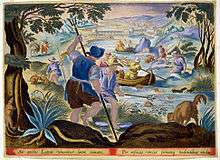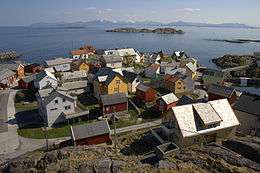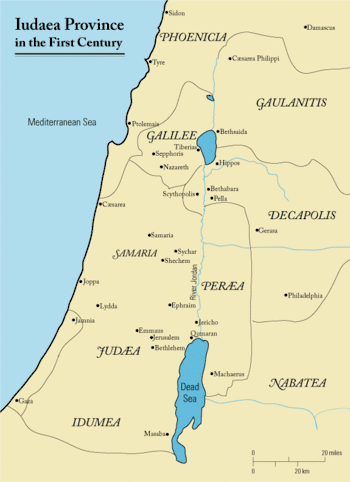Bethsaida
| בית צידה (Bet Tsaida) | |
|
| |
 Bethsaida | |
| Location | Golan Heights |
|---|---|
| History | |
| Founded | 1st century BC |
| Abandoned | 65 AD |
Bethsaida /bɛθˈseɪ.ɪdə/[1] (from Hebrew/Aramaic בית צידה beth-tsaida, lit. "house of hunting" or "fishing", from the Hebrew root צדה or צוד) is a place mentioned in the New Testament.
Bethsaida Julias
A city east of the Jordan River, it is in a "desert place" (that is, uncultivated ground used for grazing), possibly the site at which Jesus miraculously fed the multitude with five loaves and two fish (Mark 6:32; Luke 9:10). It may be possible to identify this site with the village of Bethsaida in Lower Gaulanitis which the tetrarch Herod Philip II raised to the rank of a polis in the year 30/31 CE (or 32/33 CE), and renamed it Julias, in honor of Livia, the wife of Augustus. It lay near the place where the Jordan enters the Sea of Gennesaret.[2]
To this neighborhood, Jesus retired by boat with His disciples to rest a while. The multitude following on foot along the northern shore of the lake would cross the Jordan by the ford at its mouth which is used by foot travelers to this day. The "desert" of the narrative is just the barrīyeh of the Arabs where the animals are driven out for pasture. The "green grass" of Mark 6:39, and the "much grass" of John 6:10, point to some place in the plain of el-Baṭeiḥah, on the rich soil of which the grass is green and plentiful compared with the scanty herbage on the higher slopes.
Identification
et-Tell
This city was said to be et-Tell, a ruined site on the east side of the Jordan on rising ground, 2 km from the sea. This distance poses a problem, however. Why would a fishing village be so far from the water? A combination of three hypotheses can explain this:
- Tectonic rifting has uplifted et-Tell (the site is located on the Great African-Syrian Rift fault).
- The water level has dropped from increased population usage, land irrigation. In fact excavation of Magdala's harbour has proven that the ancient water-level was much higher than it is today.[3]
- The Jordan River delta has been extended by sedimentation.
et-Tell during Bronze Age and Iron Age
Et-Tell was inhabited during the Bronze Age and Iron Age. The fortified town there is associated by researchers with the biblical kingdom of Geshur.
Recently a group of twenty archaeologists led by Rami Arav have discovered a structure identified as a city gate. They tentatively identified the city with biblical Zer, a name used during the First Temple period.[4]
el-Araj el-Mesydiah
Dissenters suggest two other sites as possible locations for Bethsaida: el-Araj and el-Mesydiah, also spelled el-Mes‛adīyeh. Both of these sites are located on the present shoreline, but preliminary excavations, including the use of ground penetrating radar, revealed only a small number of ruins not dating from before the Byzantine period. Some were inclined to favor el-Mes‛adīyeh (a ruin and winter village of Arab et-Tellawīyeh) which stands on an artificial mound about a mile and a half from the mouth of the Jordan. However, the name is in origin radically different from Bethsaida. The substitution of sin for cad is easy, but the insertion of the guttural ‛ain is impossible. No trace of the name Bethsaida has been found in the district, but any one of the sites named would meet the requirements.
In 2017, archaeologists announced the discovery of a Roman bathhouse at el-Araj, which is taken as proof that the site was a polis in the Roman period.[5] The bathhouse was located in a layer below the Byzantine layer, with an intervening layer of mud and clay that indicated a break in occupation between 250 and 350 CE.[5] They also found what might be the remains of a Byzantine church, matching the description of a traveller in 750 CE.[5] On account of these discoveries, the archaeologists believe that el-Araj is now the most likely candidate for the location of Bethsaida.[5]
Bethsaida of Galilee
Bethsaida is described in Mark 8:22–26 as a town (κώμη) where Jesus met a blind man seeking healing. Jesus led the man outside the town before healing him and asked him not to return to the town, nor to inform the people of the town, after his sight was restored.
One or two Bethsaidas?
Many scholars maintain that all the New Testament references to Bethsaida apply to one place, namely, Bethsaida Julias. The arguments for and against this view may be summarized as follows:
- Galilee ran right round the lake, including most of the level coastland on the east. Thus Gamala, on the eastern shore, was within the jurisdiction of Josephus, who commanded in Galilee.[6] Judas of Gamala[7] is also called Judas of Galilee.[8] If Gamala, far down the eastern shore of the sea, were in Galilee, a fortiori Bethsaida, a town which lay on the very edge of the Jordan, may be described as in Galilee.
- But Josephus makes it plain that Gamala, while added to his jurisdiction, was not in Galilee, but in Gaulanitis.[9] Even if Judas were born in Gamala, and so might properly be called a Gaulanite, he may, like others, have come to be known as belonging to the province in which his active life was spent. "Jesus of Nazareth" was born in Bethlehem. Then Josephus explicitly says that Bethsaida was in Lower Gaulanitis .[10] Further, Luke places the country of the Gerasenes on the other side of the sea from Galilee (Luke 8:26) – antípera tḗs Galilaias ("over against Galilee").
- To go to the other side – eis tó péran (Mark 6:45) – does not of necessity imply passing from the west to the east coast of the lake, since Josephus uses the verb diaperaióō of a passage from Tiberias to Taricheae. [11] But
- this involved a passage from a point on the west to a point on the south shore, "crossing over" two considerable bays; whereas if the boat started from any point in el-Baṭeiḥah, to which we seem to be limited by the "much grass", and by the definition of the district as belonging to Bethsaida, to sail to et-Tell or el-Araj, it was a matter of coasting not more than a couple of miles, with no bay to cross.
- No case can be cited where the phrase eis to peran certainly means anything else than "to the other side".
- Mark says that the boat started to go unto the other side to Bethsaida, while John, gives the direction "over the sea unto Capernaum" (John 6:17). The two towns were therefore practically in the same line. Now there is no question that Capernaum was on "the other side", nor is there any suggestion that the boat was driven out of its course; and it is quite obvious that, sailing toward Capernaum, whether at Tell Ḥūm or at Khān Minyeh, it would never reach Bethsaida Julias.
- The words of Mark (Mark 6:45), it is suggested,[12] have been too strictly interpreted: as the Gospel was written probably at Rome, its author being a native, not of Galilee, but of Jerusalem. Want of precision on topographical points, therefore, need not surprise us. But as we have seen above, the "want of precision" must also be attributed to the writer of John 6:17. The agreement of these two favors the strict interpretation. Further, if the Gospel of Mark embodies the recollections of Peter, it would be difficult to find a more reliable authority for topographical details connected with the sea on which his fisher life was spent.
- In support of the single-city theory it is further argued that
- Jesus withdrew to Bethsaida as being in the jurisdiction of Philip, when he heard of the murder of John the Baptist by Herod Antipas, and would not have sought again the territories of the latter so soon after leaving them.
- Medieval works of travel notice only one Bethsaida.
- The east coast of the sea was definitely attached to Galilee in AD 84, and Ptolemy (c. 140) places Julias in Galilee. It is therefore significant that only the Fourth Gospel speaks of "Bethsaida of Galilee".
- There could hardly have been two Bethsaidas so close together.
- But:
- It is not said that Jesus came hither that he might leave the territory of Antipas for that of Philip; and in view of Mark 6:30, and Luke 9:10, the inference from Matthew 14:13 that he did so, is not warranted.
- The Bethsaida of medieval writers was evidently on the west of the Jordan River. If it lay on the east, it is inconceivable that none of them should have mentioned the river in this connection.
- If the 4th Gospel was not written until well into the 2nd century, then the apostle was not the author; but this is a very precarious assumption. John, writing after AD 84, would hardly have used the phrase "Bethsaida of Galilee" of a place only recently attached to that province, writing, as he was, at a distance from the scene, and recalling the former familiar conditions.
- In view of the frequent repetition of names in Palestine the nearness of the two Bethsaidas raises no difficulty. The abundance of fish at each place furnished a good reason for the recurrence of the name.
1217 battle
During the Fifth Crusade, the well-mounted crusader army led by King Andrew II of Hungary defeated Sultan Al-Adil I at Bethsaida on the Jordan River on 10 November 1217. Muslim forces retreated to their fortresses and towns.[13][14]
See also
- The Sea of Galilee Boat
- New Testament places associated with Jesus
- Woes to the unrepentant cities, pronounced by Jesus and which include Bethsaida
References
- ↑ "Definition of Bethsaida". Dictionary.com. Retrieved 2017-12-22.
- ↑ Flavius Josephus, Antiquities of the Jews, XVIII, ii, 1; The Jewish War, II, ix, 1; III, x, 7; The Life of Flavius Josephus, 72.
- ↑ F. D. Troche, “Ancient Fishing Methods and Fishing Grounds in the Lake of Galilee” Palestine Exploration Quarterly, 148,4 (2016) 290-91.
- ↑ Zieve, Tamara. "Archaeologists uncover gate to biblical city of Zer". The Jerusalem Post. Retrieved 11 July 2018.
- 1 2 3 4 Noa Shpigel and Ruth Schuster (August 6, 2017). "The Lost Home of Jesus' Apostles Has Just Been Found, Archaeologists Say". Haaretz.
- ↑ Flavius Josephus, The Jewish War, II, xx, 4.
- ↑ Flavius Josephus, Antiquities of the Jews, XVIII, i, l.
- ↑ Flavius Josephus, Antiquities of the Jews, XVIII, i, 6
- ↑ Flavius Josephus, The Jewish War, II, xx, 6
- ↑ Flavius Josephus, The Jewish War, II, ix, 1
- ↑ Flavius Josephus, The Life of Flavius Josephus, 59
- ↑ William Sanday, Sacred Sites of the Gospels, 42.
- ↑ Jean Richard, The Crusades, c. 1071 – c. 1291. p. 298.
- ↑ Jonathan Howard (2011). The Crusades: A History of One of the Most Epic Military Campaigns of All Time. BookCaps Study Guides [for Kindle; Golgotha Press for paperback]. ISBN 9781610428040. Retrieved 12 May 2015.
Further reading
- Arav R and RA Freund (2004) Bethsaida: A City by the North Shore of the Sea of Galilee Truman State University. ISBN 978-1-931112-39-0.
- Bethsaida: An Ancient Fishing Village on the shore of the Sea of Galilee , 2001, Israel Ministry of Foreign Affairs.
- International Standard Bible Encyclopedia
External Links
- Bethsaida, Jacqueline Schaalje
- "Archaeologists discover lost home of Jesus's Apostles" by Benyamin Cohen, The Grapevine, August 7, 2017
Coordinates: 32°54′36″N 35°37′52″E / 32.910°N 35.631°E
- This article incorporates text from the International Standard Bible Encyclopediaarticle "Bethsaida", a publication now in the public domain.


